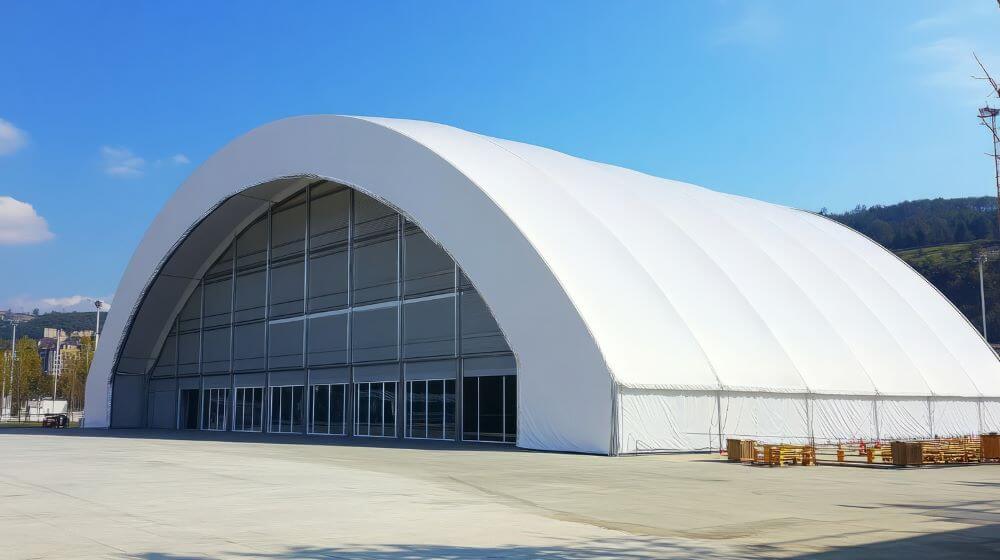Finding extra space can be a challenge, especially when time, cost, and flexibility all matter. Traditional buildings often take months to complete, and the expense doesn’t stop at construction. Modular fabric buildings offer a practical solution for organizations that need quick, reliable shelter without committing to the high costs and timeframes tied to permanent structures.
Modular fabric buildings serve a wide variety of industries, from agriculture to construction and aviation. They adapt to different site conditions, function across seasons, and meet specific project needs without the heavy investment of conventional building methods.
Why Businesses Are Turning to Commercial Fabric Buildings
Commercial fabric buildings give you the flexibility that conventional structures can’t match. These fabric shelters are designed to handle strong winds, heavy snow loads, and even extreme temperatures. You can use them across a variety of applications, including warehousing, manufacturing facilities, sports complexes, and aircraft hangars.
Fabric structures are especially helpful when you need an equipment storage building that can be deployed quickly. Compared to traditional buildings, you spend less time waiting for a building ready for use. Their modular nature allows for rapid installation, and if your space needs change, many of these structures can be relocated or expanded without significant additional cost.
What makes commercial fabric buildings particularly attractive is how they meet permit requirements while still offering versatility. Many fabric shelters are considered temporary buildings, which can speed up approval processes. They often require simpler foundations, which means fewer delays related to the ground surface or site preparation.
The Advantages of Modular Fabric Structures
Choosing modular fabric structures can solve space shortages without long-term disruption. One advantage is the ability to set up portable buildings quickly. Unlike wood buildings or steel constructions, fabric shelters often come prefabricated, needing minimal labor to assemble on-site.
The use of quality components—such as durable tensioned fabric and galvanized steel frames—provides layers of protection against environmental wear. Some designs allow natural light to flood the interior space, reducing electricity needs and creating a more pleasant environment for workers and equipment.
Fabric structures are particularly useful during the winter months. They can be engineered to support snow accumulation and keep interiors safe and functional. Heating systems can easily be integrated if necessary, turning what might have been a seasonal facility into a year-round workspace.
Cost-Effective Solutions for Growing Needs
Modular fabric buildings present a cost-effective option for financial planning when expanding office spaces, storage capacity, or operational sites. Unlike conventional buildings, you don’t have to account for lengthy construction schedules or unexpected material price increases. The shorter construction timeline helps you avoid downtime, which can translate into direct savings.
You also reduce the need for expensive groundworks. Many fabric structures can be installed on a simple foundation or even directly on a prepared ground surface. This flexibility lowers upfront site development costs and allows you to adapt the building location as operational needs change.
Temporary buildings like these provide a smart alternative when you need to react quickly to new contracts, seasonal demand, or project expansions. Instead of committing to expensive permanent structures that might later sit unused, you can scale your infrastructure in a practical, measured way.
How Modular Fabric Buildings Serve Different Industries
A variety of industries benefit from the adaptability of modular fabric structures. In the construction industry, companies use them for equipment storage, worker housing, and mobile office spaces. Mining operations turn to fabric shelters for machine maintenance facilities and bulk material storage.
In manufacturing, fabric buildings serve as warehouses, assembly lines, and distribution centers. Their clear-span design means there are no interior support columns to interrupt workflows, making them ideal for large machinery and open production areas.
The aviation sector often uses fabric structures as hangars, maintenance bays, and cargo shelters. Because they can withstand strong winds and heavy loads, they offer reliable protection for valuable aircraft without the time and expense linked to conventional hangars.
Agricultural businesses rely on modular fabric shelters for crop storage, livestock housing, and equipment protection, especially during the winter months. The natural light provided by the fabric covering helps maintain healthier environments for plants and animals, which can have a direct impact on productivity.
Practical Considerations Before Setting Up
Before setting up a modular fabric building, it’s smart to think through a few key factors. Check local permit requirements to confirm what’s needed for temporary or semi-permanent structures in your area. While many fabric shelters qualify as temporary buildings, regulations can vary.
Evaluate the ground surface where you plan to install the structure. Some portable buildings need a prepared gravel pad or a simple concrete slab to perform optimally. The right foundation not only supports the structure but also extends its life.
Consider the weather conditions your building must handle. Structures can be customized with insulation, HVAC systems, and reinforced frames to suit high winds, heavy snow, or extremely hot or cold climates. Investing in the right options at the start helps avoid expensive retrofits later.
Finally, match the design to your operational needs. Whether you need an equipment storage building, new office spaces, or manufacturing facilities, selecting the right size, features, and quality components will make your fabric structure a lasting asset.




